 Technology peripherals
Technology peripherals
 AI
AI
 Google's new method ASPIRE: gives LLM self-scoring capabilities, effectively solves the 'illusion' problem, and surpasses 10 times the volume model
Google's new method ASPIRE: gives LLM self-scoring capabilities, effectively solves the 'illusion' problem, and surpasses 10 times the volume model
Google's new method ASPIRE: gives LLM self-scoring capabilities, effectively solves the 'illusion' problem, and surpasses 10 times the volume model
The "illusion" problem of large models will soon be solved?
Researchers at the University of Wisconsin-Madison and Google recently launched the ASPIRE system, which enables large models to self-evaluate their output.
If the user sees that the result generated by the model has a low score, they will realize that the reply may be an illusion.
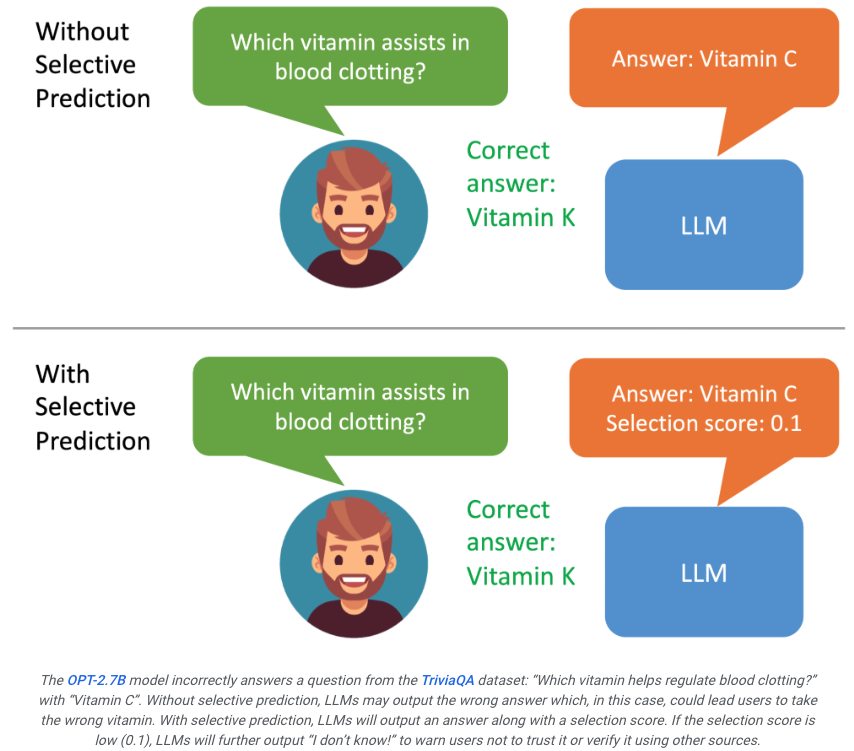
If the system can further filter the output based on the score, for example when the score is low, the large model can generate something like "I can't answer this question" " statement, which may improve the hallucination problem to the greatest extent.

Paper address: https://aclanthology.org/2023.findings-emnlp.345.pdf
ASPIRE allows LLM to output the answer and the confidence score of the answer.
The researchers’ experimental results show that ASPIRE significantly outperforms traditional selective prediction methods on various QA datasets such as the CoQA benchmark.
Let LLM not only answer questions, but also evaluate those answers.
In the benchmark test of selective prediction, the researchers achieved results of more than 10 times the scale of the model through the ASPIRE system.
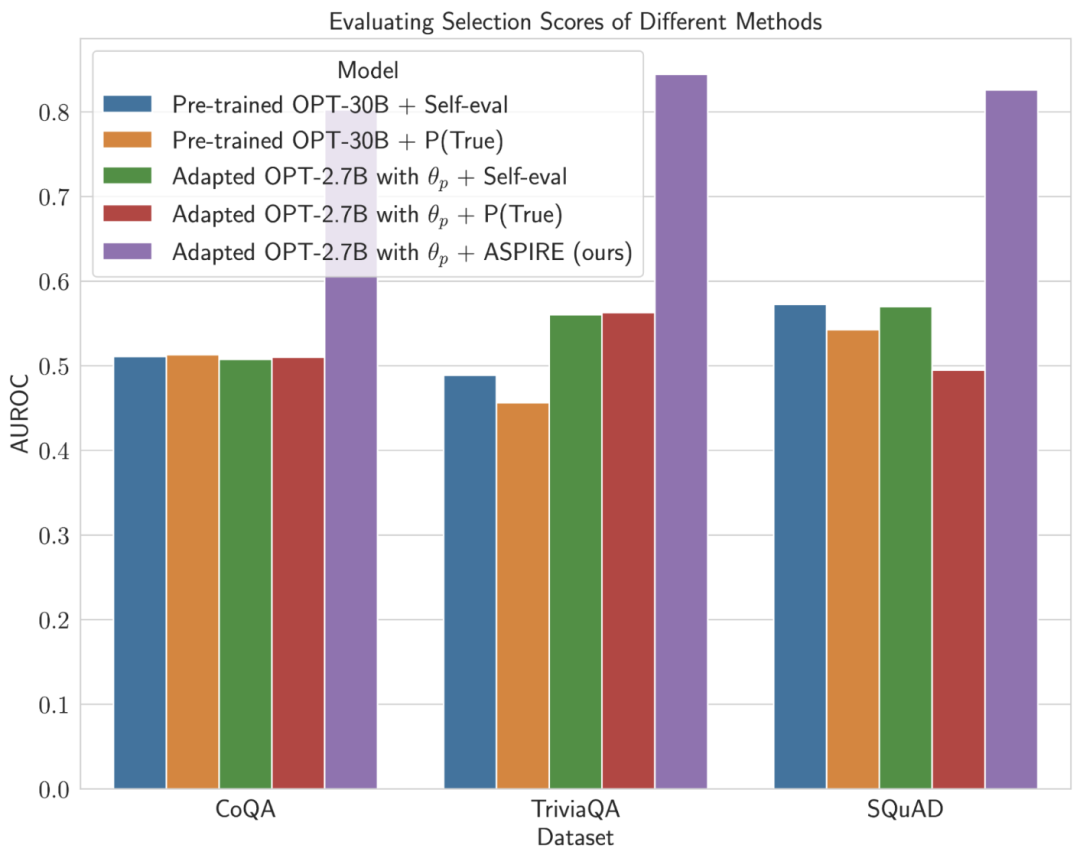
It’s like asking students to verify their own answers at the back of the textbook. Although it sounds a bit unreliable, if you think about it carefully, everyone After completing a question, there will indeed be a score for the degree of satisfaction with the answer.
This is the essence of ASPIRE, which involves three phases:
(1) Tuning for a specific task,
(2) Answer sampling,
(3) Self-assessment learning.
In the eyes of researchers, ASPIRE is not just another framework, it represents a bright future that comprehensively improves LLM reliability and reduces hallucinations. .
If LLM can become a trusted partner in the decision-making process.
By continuously optimizing the ability to make selective predictions, humans are one step closer to fully realizing the potential of large models.
Researchers hope to use ASPIRE to start the evolution of the next generation of LLM, thereby creating more reliable and self-aware artificial intelligence.
ASPIRE’s mechanics
Fine-tuning for specific tasks
ASPIRE performs task-specific fine-tuning to train adaptive parameters while freezing the LLM.  Given a training dataset for the generation task, it fine-tunes the pre-trained LLM to improve its prediction performance.
Given a training dataset for the generation task, it fine-tunes the pre-trained LLM to improve its prediction performance.
To this end, parameter-efficient fine-tuning techniques (e.g., soft-cue word fine-tuning and LoRA) can be employed to fine-tune pre-trained LLMs on the task, as they can be efficiently obtained with a small number of targets Strong generalization task data.
Specifically, the LLM parameters (θ) are frozen, and adaptive parameters
are added for fine-tuning.  Only update θ (p) to minimize the standard LLM training loss (e.g. cross-entropy).
Only update θ (p) to minimize the standard LLM training loss (e.g. cross-entropy).
This kind of fine-tuning can improve selective prediction performance because it not only improves prediction accuracy, but also increases the likelihood of correctly outputting the sequence.
Answer sampling
## After being tuned for a specific task, ASPIRE uses LLM and learned  Generate different answers for each training question and create a dataset for self-evaluation learning.
Generate different answers for each training question and create a dataset for self-evaluation learning.
The researcher’s goal is to generate output sequences with high likelihood. They used Beam Search as the decoding algorithm to generate high-likelihood output sequences and used the Rouge-L metric to determine whether the generated output sequences were correct.
Self-evaluation learning
After sampling the high-likelihood output for each query, ASPIRE adds self-evaluation Adapt parameters  and fine-tune only
and fine-tune only  to learn self-evaluation.
to learn self-evaluation.
Since the generation of the output sequence depends only on θ and  , freezing θ and the learned
, freezing θ and the learned  can be avoided Changing LLM's predictive behavior when learning self-evaluation.
can be avoided Changing LLM's predictive behavior when learning self-evaluation.
The researchers optimized  so that the adapted LLM can distinguish correct and incorrect answers on its own.
so that the adapted LLM can distinguish correct and incorrect answers on its own.
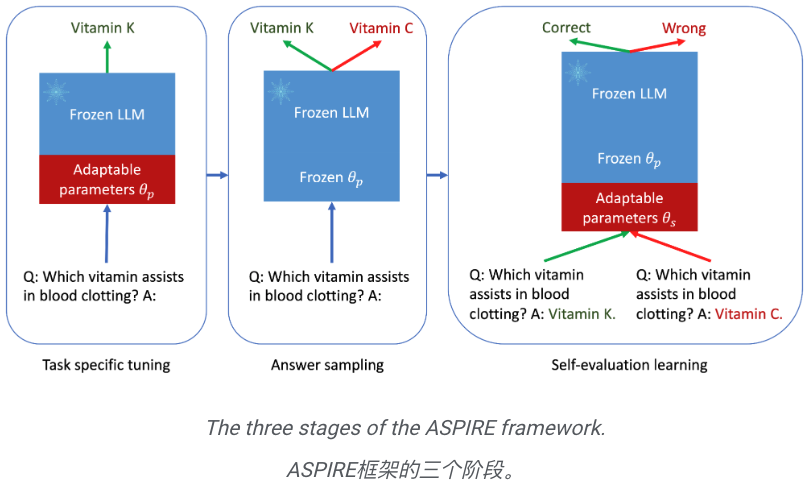
In this framework, any parameter-valid fine-tuning method can be used to train  and
and  .
.
In this work, the researchers used soft-cue fine-tuning, a simple yet effective mechanism for learning "soft cues" to tune frozen language models, thereby Perform specific downstream tasks more efficiently than traditional discrete text prompts.
The core behind this approach is the recognition that if cues can be developed that effectively stimulate self-evaluation, it should be discoverable through fine-tuning of soft cues combined with targeted training goals These tips.
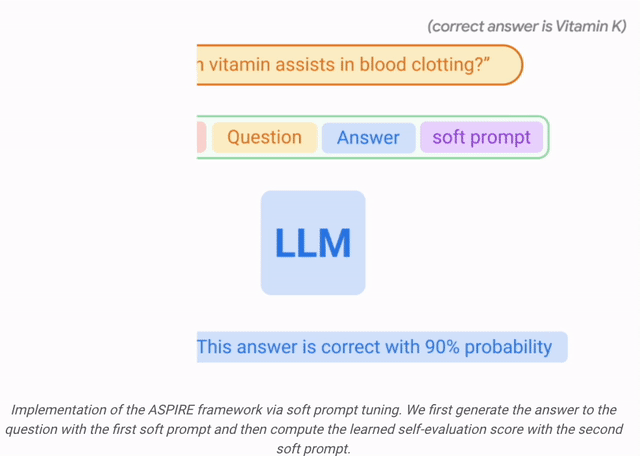
After training  and
and  , the researchers decoded by beam search Get predictions for the query (beam search decoding).
, the researchers decoded by beam search Get predictions for the query (beam search decoding).
The researchers then define a choice score that combines the likelihood of generating an answer with the learned self-assessment score (i.e., the likelihood that the prediction is correct for the query) to do Make selective predictions.
Results
To demonstrate the effect of ASPIRE, the researchers used various open pre-trained Transformer (OPT) models on three question and answer data Evaluate it on the set (CoQA, TriviaQA and SQuAD).
By adjusting training using soft cues The researchers observed a substantial improvement in the accuracy of LLM.
The researchers observed a substantial improvement in the accuracy of LLM.
For example, the OPT-2.7B model with ASPIRE showed better performance than the larger pre-trained OPT-30B model using the CoQA and SQuAD datasets.
These results suggest that with appropriate tuning, smaller LLMs may have the ability to match or possibly exceed the accuracy of larger models in some situations.
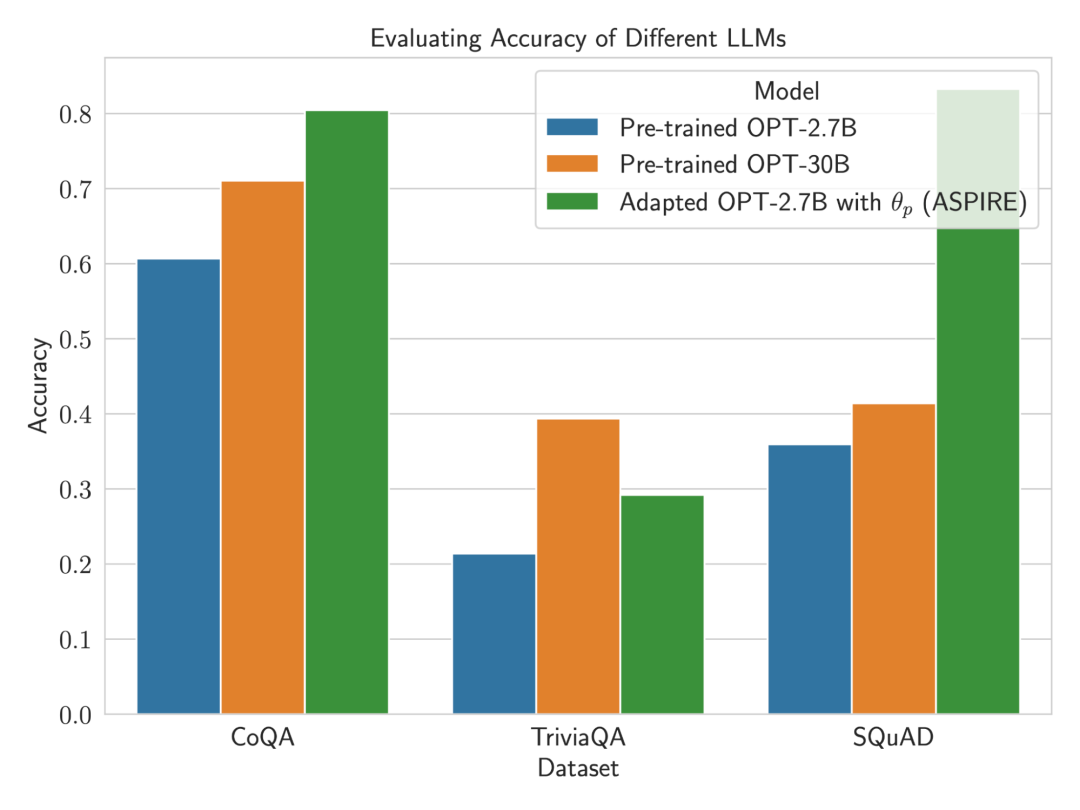
When delving into the calculation of selection scores for fixed model predictions, ASPIRE achieved higher AUROC scores than the baseline method for all datasets (random The probability that a selected correct output sequence has a higher selection score than a randomly selected incorrect output sequence).
For example, on the CoQA benchmark, ASPIRE improves AUROC from 51.3% to 80.3% compared to the baseline.
An interesting pattern emerged from the evaluation of the TriviaQA dataset.
Although the pre-trained OPT-30B model exhibits higher baseline accuracy, its choice when applying traditional self-evaluation methods (Self-eval and P(True)) The performance of sex prediction is not significantly improved.
In contrast, the much smaller OPT-2.7B model outperformed other models in this regard after being enhanced with ASPIRE.
This difference reflects an important issue: larger LLMs that utilize traditional self-assessment techniques may not be as effective at selective prediction as smaller ASPIRE-enhanced models.

The researchers’ experimental journey with ASPIRE highlights a key shift in the LLM landscape: A language model’s capacity is not the be-all and end-all of its performance .
Instead, model effectiveness can be greatly improved through policy adjustments, allowing for more accurate and confident predictions even in smaller models.
Thus, ASPIRE demonstrates the potential of LLMs to sensibly determine the certainty of their own answers and significantly outperform others 10 times their size in selective prediction tasks. Model.
The above is the detailed content of Google's new method ASPIRE: gives LLM self-scoring capabilities, effectively solves the 'illusion' problem, and surpasses 10 times the volume model. For more information, please follow other related articles on the PHP Chinese website!

Hot AI Tools

Undresser.AI Undress
AI-powered app for creating realistic nude photos

AI Clothes Remover
Online AI tool for removing clothes from photos.

Undress AI Tool
Undress images for free

Clothoff.io
AI clothes remover

AI Hentai Generator
Generate AI Hentai for free.

Hot Article

Hot Tools

Notepad++7.3.1
Easy-to-use and free code editor

SublimeText3 Chinese version
Chinese version, very easy to use

Zend Studio 13.0.1
Powerful PHP integrated development environment

Dreamweaver CS6
Visual web development tools

SublimeText3 Mac version
God-level code editing software (SublimeText3)

Hot Topics
 Use ddrescue to recover data on Linux
Mar 20, 2024 pm 01:37 PM
Use ddrescue to recover data on Linux
Mar 20, 2024 pm 01:37 PM
DDREASE is a tool for recovering data from file or block devices such as hard drives, SSDs, RAM disks, CDs, DVDs and USB storage devices. It copies data from one block device to another, leaving corrupted data blocks behind and moving only good data blocks. ddreasue is a powerful recovery tool that is fully automated as it does not require any interference during recovery operations. Additionally, thanks to the ddasue map file, it can be stopped and resumed at any time. Other key features of DDREASE are as follows: It does not overwrite recovered data but fills the gaps in case of iterative recovery. However, it can be truncated if the tool is instructed to do so explicitly. Recover data from multiple files or blocks to a single
 Open source! Beyond ZoeDepth! DepthFM: Fast and accurate monocular depth estimation!
Apr 03, 2024 pm 12:04 PM
Open source! Beyond ZoeDepth! DepthFM: Fast and accurate monocular depth estimation!
Apr 03, 2024 pm 12:04 PM
0.What does this article do? We propose DepthFM: a versatile and fast state-of-the-art generative monocular depth estimation model. In addition to traditional depth estimation tasks, DepthFM also demonstrates state-of-the-art capabilities in downstream tasks such as depth inpainting. DepthFM is efficient and can synthesize depth maps within a few inference steps. Let’s read about this work together ~ 1. Paper information title: DepthFM: FastMonocularDepthEstimationwithFlowMatching Author: MingGui, JohannesS.Fischer, UlrichPrestel, PingchuanMa, Dmytr
 Hello, electric Atlas! Boston Dynamics robot comes back to life, 180-degree weird moves scare Musk
Apr 18, 2024 pm 07:58 PM
Hello, electric Atlas! Boston Dynamics robot comes back to life, 180-degree weird moves scare Musk
Apr 18, 2024 pm 07:58 PM
Boston Dynamics Atlas officially enters the era of electric robots! Yesterday, the hydraulic Atlas just "tearfully" withdrew from the stage of history. Today, Boston Dynamics announced that the electric Atlas is on the job. It seems that in the field of commercial humanoid robots, Boston Dynamics is determined to compete with Tesla. After the new video was released, it had already been viewed by more than one million people in just ten hours. The old people leave and new roles appear. This is a historical necessity. There is no doubt that this year is the explosive year of humanoid robots. Netizens commented: The advancement of robots has made this year's opening ceremony look like a human, and the degree of freedom is far greater than that of humans. But is this really not a horror movie? At the beginning of the video, Atlas is lying calmly on the ground, seemingly on his back. What follows is jaw-dropping
 Google is ecstatic: JAX performance surpasses Pytorch and TensorFlow! It may become the fastest choice for GPU inference training
Apr 01, 2024 pm 07:46 PM
Google is ecstatic: JAX performance surpasses Pytorch and TensorFlow! It may become the fastest choice for GPU inference training
Apr 01, 2024 pm 07:46 PM
The performance of JAX, promoted by Google, has surpassed that of Pytorch and TensorFlow in recent benchmark tests, ranking first in 7 indicators. And the test was not done on the TPU with the best JAX performance. Although among developers, Pytorch is still more popular than Tensorflow. But in the future, perhaps more large models will be trained and run based on the JAX platform. Models Recently, the Keras team benchmarked three backends (TensorFlow, JAX, PyTorch) with the native PyTorch implementation and Keras2 with TensorFlow. First, they select a set of mainstream
 Slow Cellular Data Internet Speeds on iPhone: Fixes
May 03, 2024 pm 09:01 PM
Slow Cellular Data Internet Speeds on iPhone: Fixes
May 03, 2024 pm 09:01 PM
Facing lag, slow mobile data connection on iPhone? Typically, the strength of cellular internet on your phone depends on several factors such as region, cellular network type, roaming type, etc. There are some things you can do to get a faster, more reliable cellular Internet connection. Fix 1 – Force Restart iPhone Sometimes, force restarting your device just resets a lot of things, including the cellular connection. Step 1 – Just press the volume up key once and release. Next, press the Volume Down key and release it again. Step 2 – The next part of the process is to hold the button on the right side. Let the iPhone finish restarting. Enable cellular data and check network speed. Check again Fix 2 – Change data mode While 5G offers better network speeds, it works better when the signal is weaker
 The vitality of super intelligence awakens! But with the arrival of self-updating AI, mothers no longer have to worry about data bottlenecks
Apr 29, 2024 pm 06:55 PM
The vitality of super intelligence awakens! But with the arrival of self-updating AI, mothers no longer have to worry about data bottlenecks
Apr 29, 2024 pm 06:55 PM
I cry to death. The world is madly building big models. The data on the Internet is not enough. It is not enough at all. The training model looks like "The Hunger Games", and AI researchers around the world are worrying about how to feed these data voracious eaters. This problem is particularly prominent in multi-modal tasks. At a time when nothing could be done, a start-up team from the Department of Renmin University of China used its own new model to become the first in China to make "model-generated data feed itself" a reality. Moreover, it is a two-pronged approach on the understanding side and the generation side. Both sides can generate high-quality, multi-modal new data and provide data feedback to the model itself. What is a model? Awaker 1.0, a large multi-modal model that just appeared on the Zhongguancun Forum. Who is the team? Sophon engine. Founded by Gao Yizhao, a doctoral student at Renmin University’s Hillhouse School of Artificial Intelligence.
 Kuaishou version of Sora 'Ke Ling' is open for testing: generates over 120s video, understands physics better, and can accurately model complex movements
Jun 11, 2024 am 09:51 AM
Kuaishou version of Sora 'Ke Ling' is open for testing: generates over 120s video, understands physics better, and can accurately model complex movements
Jun 11, 2024 am 09:51 AM
What? Is Zootopia brought into reality by domestic AI? Exposed together with the video is a new large-scale domestic video generation model called "Keling". Sora uses a similar technical route and combines a number of self-developed technological innovations to produce videos that not only have large and reasonable movements, but also simulate the characteristics of the physical world and have strong conceptual combination capabilities and imagination. According to the data, Keling supports the generation of ultra-long videos of up to 2 minutes at 30fps, with resolutions up to 1080p, and supports multiple aspect ratios. Another important point is that Keling is not a demo or video result demonstration released by the laboratory, but a product-level application launched by Kuaishou, a leading player in the short video field. Moreover, the main focus is to be pragmatic, not to write blank checks, and to go online as soon as it is released. The large model of Ke Ling is already available in Kuaiying.
 The U.S. Air Force showcases its first AI fighter jet with high profile! The minister personally conducted the test drive without interfering during the whole process, and 100,000 lines of code were tested for 21 times.
May 07, 2024 pm 05:00 PM
The U.S. Air Force showcases its first AI fighter jet with high profile! The minister personally conducted the test drive without interfering during the whole process, and 100,000 lines of code were tested for 21 times.
May 07, 2024 pm 05:00 PM
Recently, the military circle has been overwhelmed by the news: US military fighter jets can now complete fully automatic air combat using AI. Yes, just recently, the US military’s AI fighter jet was made public for the first time and the mystery was unveiled. The full name of this fighter is the Variable Stability Simulator Test Aircraft (VISTA). It was personally flown by the Secretary of the US Air Force to simulate a one-on-one air battle. On May 2, U.S. Air Force Secretary Frank Kendall took off in an X-62AVISTA at Edwards Air Force Base. Note that during the one-hour flight, all flight actions were completed autonomously by AI! Kendall said - "For the past few decades, we have been thinking about the unlimited potential of autonomous air-to-air combat, but it has always seemed out of reach." However now,





